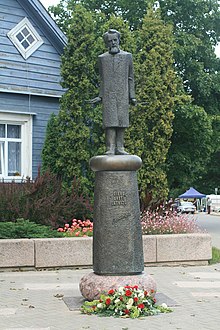Limbaži
Limbaži | |
|---|---|
Town | |
 Limbaži old town | |
| Country | |
| District | Limbaži municipality |
| City status | 1385 |
| Government | |
| • Mayor | Juris Žūriņš |
| Area | |
| • Total | 9.021 km2 (3.483 sq mi) |
| Population (2008) | |
| • Total | 8,705 |
| • Density | 989/km2 (2,560/sq mi) |
| Time zone | UTC+2 (EET) |
| • Summer (DST) | UTC+3 (EEST) |
| Postal code | LV-4001 |
| Calling code | 640 |
| Website | http://www.limbazi.lv |
Limbaži (, Template:Lang-et, Template:Lang-de, Template:Lang-liv) is a town in the Vidzeme region of northern Latvia. Limbaži is located 90 km northeast of the capital Riga. The population is 8705 people. During the Middle Ages, as part of Livonia, Limbazi was a fortified town with stone walls, second in importance only to Riga.
Etymology
The name Lämmist nīn is believed to be a Livonian word meaning "wide isle in a forest swamp". The German Lemsahl is derived from the Livonian name.
According to folk etymology, the name Limbaži originated sometime in the 17th century. A recently arrived Swedish minister overheard some gibberish, "limba" and "aži". Mistakenly, he assumed this was the name of the village, and so the town was called "Limbaži".
History
In ancient times, Limbaži was a Livonian settlement known as Lemisele, part of Metsepole. In the early 13th century, Bishop Albert and the Teutonic knights destroyed the village while conquering Metsepole, and built a castle, around which formed the new city, Lemsahl.
Medieval Limbaži
Until the beginning of the 16th century, Lemsahl could be reached by seagoing vessels travelling up the Svētupe. Ships came from as far as Lübeck and Copenhagen to trade for honey, wax, lumber, grain, and furs. The small trading camp surrounding the castle grew into a large town, and was admitted to the Hanseatic League. Each year, Lemsahl hosted a conference attended by barons from all over Livonia, and the city hosted at least three other fairs throughout the year as well. During these fairs, the town may have held as many as 20,000 people at once. In addition, the Bishop of Riga made Lemsahl his spring residence, which became a walled city to protect both the bishop and the trading center. In population, Lemsahl was second only to Riga.
By 1500, however, the Svētupe became too shallow to navigate. Goods were sent elsewhere, and Lemsahl began a century long decline. During the Livonian War, Ivan the Terrible's forces burned down Lemsahl in 1558, while its residents fled to the nearby forests and marshes for shelter. The city was burned down by the Swedes in 1567, and again by the Russians in 1575. In 1602, the Swedes and Poles fought yet again for the city, completely demolishing its fortifications and walls. By the time the wars had ended, the city was so demolished, only three houses and a handful of residents remained.
18th and 19th centuries
While under Swedish rule, the village was renamed Limbaži sometime in the 17th century. During the Great Northern War, Vidzeme was totally ravaged by Peter the Great's forces. But as the story goes, while searching for Limbaži, the Russian army got lost in a heavy fog. After stumbling in circles, the soldiers began to believe such a village may not exist after all, and moved on. Limbaži survived the war unscathed.
The city completely burned down again in 1747, after which today's city layout began to develop. In the 19th century, the city began to grow again. In 1821 there were 674 inhabitants, but by 1900 there were about 2000. In 1876, hat-maker A.Tīls opened "Limbažu Filcs", the town's oldest company, which also secured jobs for generations of the city's inhabitants. The first town library was built in the late 19th century, and several publishing houses were opened, the largest of which was K.Paucīsis Press.
Twentieth century
After World War I Limbaži continued to grow. The long-awaited rail line to Riga opened in 1934, and a 50-bed hospital opened in 1936. During the Soviet occupation the population increased to 8,000, with many five-storey Soviet-style apartments appearing in the 1960s. During the Soviet period, Limbaži became a factory-town with "Lauktehnika" farm machinery, "Limbažu Filcs" hats, and "Limbažu Piens" one of the largest milk processors in Latvia, all based there.
Demographics
| 1385 | 1622 | 1773 | 1800 | 1840 | 1863 | 1881 | 1897 | 1914 | 1920 | 1925 | 1930 | 1943 | 1959 | 1970 | 1979 | 1989 | 1997 | 2004 | |
|---|---|---|---|---|---|---|---|---|---|---|---|---|---|---|---|---|---|---|---|
| Population | 6000 | 12 | 549 | 600 | 877 | 1134 | 1814 | 2412 | 4700 | 2501 | 3085 | 2935 | 2806 | 4823 | 5791 | 8257 | 9985 | 9522 | 8934 |
Notable residents
- Kārlis Baumanis (May 11, 1835 – January 10, 1905), composer of the Latvian national anthem, "Dievs, svētī Latviju!"

Notable locations
- Limbaži old town, with remains of the town wall
- Ruins of the Archbishop's castle
- Limbaži museum of history
- Livonian hill-fort at Ķezberkalns
- "Svētais Jānis" Lutheran Church
- Kārlis Baumanis grave and monument
- Limbažu Lielezers (Lake Limbaži)
- The national Olympic training center for canoeing and kayaking is situated in Limbaži
Sister cities
References
- Limbaži history (Latvian)
- Turlajs, Janis, ed. Latvijas Celvedis. 2nd ed. Riga, Latvia: Jana Seta, 2007. 200-01.
- Latvijas Pilsetas. Riga, Latvia: Preses Nams, 1999. 284-291.


